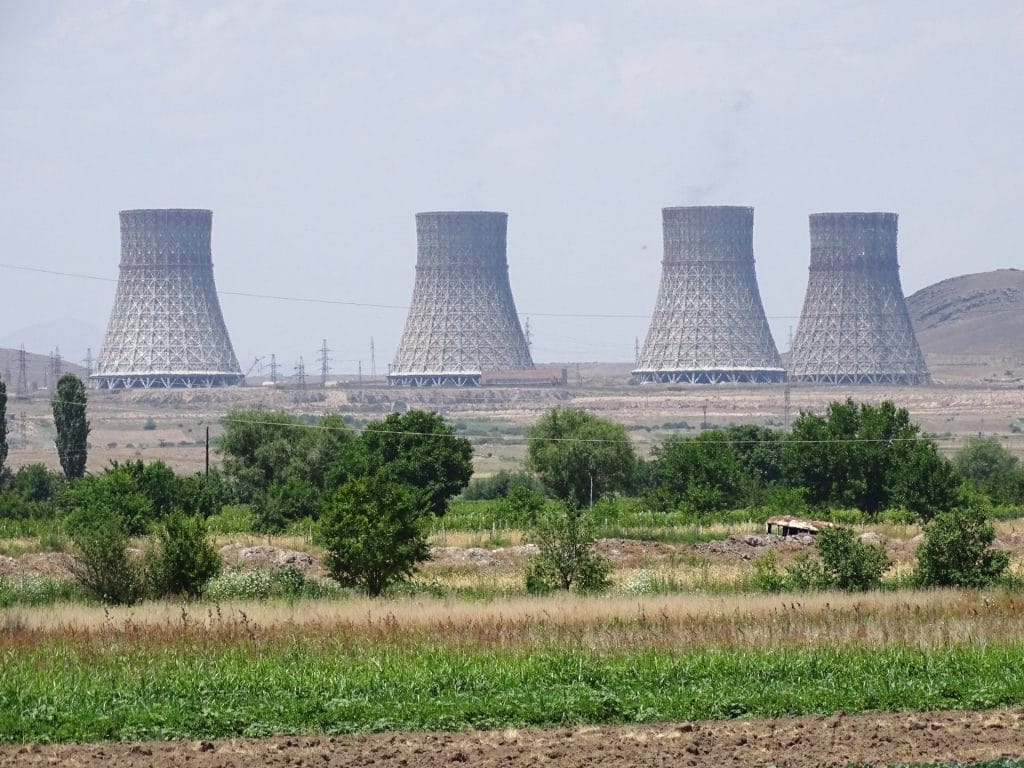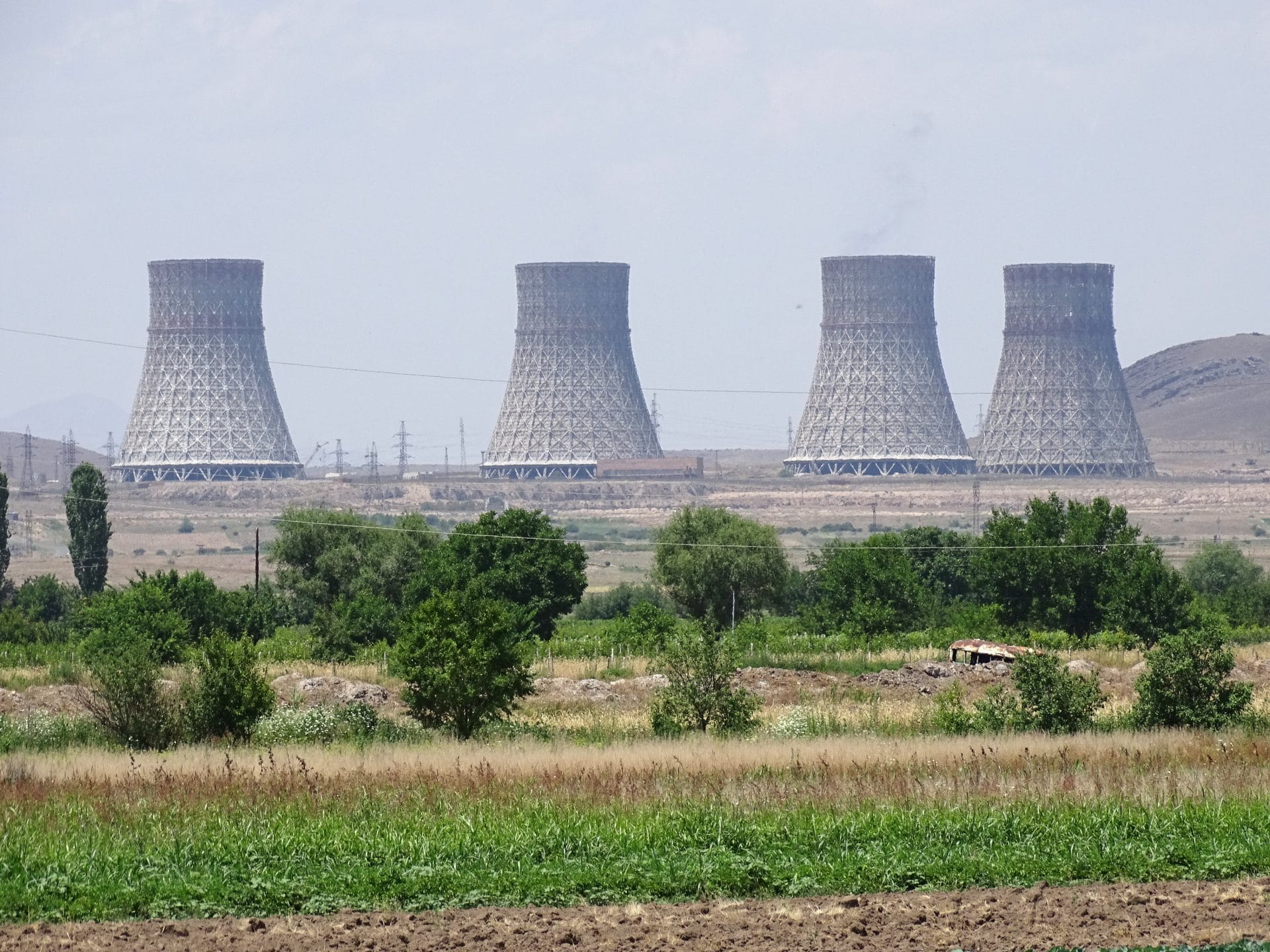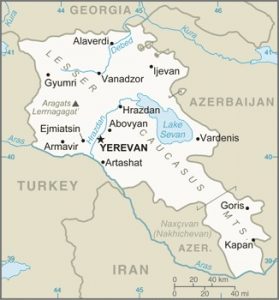 Armenia's Metsamor nuclear power plant cooling towers. (Credit: Adam Jones via Wikimedia Commons. CC BY-SA 2.0)
Armenia's Metsamor nuclear power plant cooling towers. (Credit: Adam Jones via Wikimedia Commons. CC BY-SA 2.0)
 Armenia's Metsamor nuclear power plant cooling towers. (Credit: Adam Jones via Wikimedia Commons. CC BY-SA 2.0)
Armenia's Metsamor nuclear power plant cooling towers. (Credit: Adam Jones via Wikimedia Commons. CC BY-SA 2.0)
The world is currently in the process of reevaluating its past rejection of nuclear power and is increasingly starting to view it as a reliable source of power that allows for greater energy security. This is at least in part due to the energy crisis that befell Europe after the Russian invasion of Ukraine in 2022, vindicating past worries that over-reliance on fossil fuels from autocratic regimes has made the Western countries vulnerable to political blackmail.
It is now clear that Western use of natural gas and petroleum from aggressive dictatorships—which use cash flows from oil and gas sales to reinforce and expand their hold on power—has backfired badly. In this context, the experience of Armenia—a small country that draws 40 percent of its energy from nuclear power—is instructive, showing how nuclear power can be instrumental in building societal reliance and political stability.
Living in the dark cold. It is the winter of 1992–1993. As I climb the dark stairs in a freezing-cold Soviet apartment building in Yerevan, the capital of Armenia where my family and I live, the water from the two full buckets I carry is splashing down my legs and freezing on the stairs. My sister Shooshan and I, 14 and 15, are carrying water up to our 11th-floor apartment. The water to our apartment shut off weeks ago, and we get at most one hour of electricity each day. I estimate that we need exactly seven gallons of water, if we are careful, for our basic daily needs. So, we repeat the trip every day. During the precious hour when we do get electricity, my mother rushes to the kitchen to cook food for the next 24 hours. I run to the bakery, where I stand in a long queue to buy the half pound of bread that the state has rationed for each one of us.
The daily routine, which goes on for the whole winter, is exhausting. But it is also empowering. As teenagers we feel that we are stronger than the disastrous conditions inflicted on us by the combination of the Soviet collapse, the Nagorno-Karabakh war, and the ensuing severe energy crisis.
The reasons that my sister and I—and the thousands of other Armenian teenagers like us—had to lug water and plan their lives around the one hour of electricity during that cruel winter go back to the turbulent events that shook Armenia during the preceding decades.

Map of Armenia. Credit: The World Factbook 2021. Central Intelligence Agency.
In the 1970s and 1980s, the Soviet Union—which Armenia was part of—rapidly expanded its fleet of nuclear reactors to support its growing industrial energy needs. As a result, two pressurized water reactors (PWR) of the Soviet VVER-440 type were built in the Armenian town of Metsamor, about 30 kilometers west of Yerevan. Started in 1977 and 1980, respectively, the two reactors quickly covered more than half of the energy needs of the Armenian Soviet Socialist Republic. (The remainder of the electricity was generated by Armenia’s hydroelectric stations and gas-fired power plants.) The Armenia of the 1980s was a tiny but prosperous Soviet republic that prided itself in a highly educated labor force, an array of scientific institutes, and a vibrant electronics industry that produced some of the early Soviet computer mainframe designs.
A series of violent events during the collapse of the Soviet Union would dramatically alter the Armenian dream.
Chernobyl. On April 26, 1986, one of the Soviet-designed, graphite-moderated RBMK reactors at the Chernobyl nuclear power plant underwent a catastrophic power excursion that ripped the reactor open. The explosion and fire that followed propelled an enormous amount of radioactive matter into the open atmosphere leading to what is now known as the Chernobyl nuclear disaster, with widespread radioactive contamination, hundreds of deaths from acute radiation poisoning, and likely thousands of additional deaths due to radiation-induced cancers in the months and years that followed.
The Chernobyl accident resonated worldwide, dramatically undermining public trust in nuclear power as a safe source of energy. The public perception of danger from nuclear power was magnified by the outrageous lies that the Soviet leadership spread about the disaster, the obvious incompetence and irresponsibility of the Soviet nuclear designers who built and operated the Chernobyl reactor, and the poorly executed cleanup efforts which were compounded by miscalculations and gross mistakes.
Overnight, citizens across the Soviet Union and beyond went from a blissful ignorance about radiation to an understandable—yet irrational—fear of anything radiation-related. People in Armenia, despite living more than 2,000 kilometers away from Chernobyl, started perceiving radioactive threats everywhere, often attributing many of their common ailments to radiation. Physicists, like my parents, tried to explain what radiation is and how natural doses of radiation are not dangerous. But their advice was sometimes met with hostility: Weren’t the builders of Chernobyl also scientists?
In one chilling conversation that I witnessed at a dinner party, one of the guests told my father only half in jest, “You physicists… you should all be shot!” To paraphrase Valery Legasov’s eponymous character from HBO’s five-part mini-series “Chernobyl”: The danger of the lies is not that we mistake them for the truth, but that when enough lies are told we lose hope in the truth and start believing in stories. (Legasov was a Soviet chemist who actively worked on the causes and consequences of the Chernobyl disaster. Concerned by the lack of nuclear safety in the Soviet nuclear industry, he died by suicide on April 27, 1988.)
An earthquake, the Soviet collapse, and war. In December 1988, the devastating earthquake of Spitak killed 50,000 people—a harrowing 2 percent of Armenia’s population—and destroyed most of the country’s infrastructure. The two VVER-440 reactors at Metsamor were suddenly in the public eye. Would another earthquake rip them open and turn Armenia’s heartland, where half of Armenia’s population lived, into a Chernobyl-like radioactive wasteland?
To be clear, the PWRs at Metsamor are safer than the shoddily designed, graphite-moderated reactors at Chernobyl. Metsamor’s Soviet reactor design is close to the standard PWR designs that are still the most common reactor technology used in Western countries. And the buildings and the reactor structures were reinforced to account for Armenia’s seismic activity. But none of that mattered. After the Soviet government’s grotesque lies about the Chernobyl disaster, the official assurances that the Metsamor reactors were safe did not convince many. Legasov’s intuition was right: The pursuit for truth was replaced with belief in conspiratorial rumors. An environmentalist movement sprang up, calling for the shutdown of the Metsamor reactors. The authorities backed down, and the two reactors were turned off on February 25 and March 18, 1989.
Shortly after the shutdown, the Soviet Union started to crack, finally collapsing in 1991. In neighboring Azerbaijan, an Armenian minority living in the mountainous Nagorno-Karabakh region, feeling marginalized and discriminated against, had long been fighting to protect their civil rights. With the weakening of Soviet power, the protest movement turned into demands for secession from Azerbaijan. The response in Azerbaijan was a series of brutal anti-Armenian pogroms in the cities of Sumgait and Baku that killed hundreds of Armenian civilians and forced about 300,000 others to flee the country. Fearing retaliation, the Azeri civilians living in Armenia fled en masse to Azerbaijan.
A relatively peaceful political disagreement had suddenly turned into a violent conflict, with Azerbaijan’s pogroms against Armenians escalating to a total war against the Armenian people of Nagorno-Karabakh. As the Armenian government supported the Nagorno-Karabakh secessionists, Azerbaijan retaliated by shutting off some of the natural gas pipelines that led to Armenia. In a sense, Azerbaijan’s authorities did to Armenia what Russian President Vladimir Putin is now doing to Western European countries that support Ukraine’s war effort. With its nuclear reactors and natural gas supply shut down, Armenia was left with a reduced capacity to generate electricity.
Then came the winter of 1992–1993. Mountain rivers froze, hydroelectric dams dried up, and suddenly hydropower too was nearly gone. Armenia was getting barely a trickle of electricity. What followed is a period now known in Armenia as “tsurt u mut tariner,” literally the cold and dark years: severe shortages of electricity, freezing concrete apartment complexes, closed schools, and many other disruptions. The economy collapsed, with Armenia’s gross domestic product contracting by an estimated 50 to 80 percent between 1990 and 1993. Then, a massive exodus followed, shrinking Armenia’s population by a quarter in just a few years.
Nuclear power revival. The Armenian public quickly realized that, by abandoning nuclear power, it had forfeited the country’s energy independence. That vulnerability was—and still is—very effectively leveraged by its arch-enemy Azerbaijan. Was it too late to restore nuclear power?
Understanding their mistake, the Armenian authorities re-evaluated their past decision. The choice was stark: Either indulge in exaggerated fears of radiation and face unpredictable consequences, or sober up and accept nuclear power as a lesser evil. Ultimately the government chose the sober option. But rather than rushing headfirst to hastily restart the Metsamor nuclear power plant, the authorities decided to make significant safety improvements to the reactors.
One of the Metsamor reactors finally restarted on November 5, 1995, just before the winter season. The desperately needed 400 megawatts flowed again into the small country’s languishing power grid. Almost overnight, lights were turned on, water pumps worked again, and industries revved up to capacity. Children like my sister and I stopped their exhausting routine and Armenia became a net exporter of electricity.
Over the 13 years that followed, Armenia’s economy grew by an unprecedented 700 percent. The difficult decision to restore nuclear power had saved Armenia and had put it on a path of development. In 2020, about 35 percent of electricity generated in Armenia came from nuclear, 25 percent came from renewables (primarily hydropower), and the remaining 40 percent from fossil fuels. (In 2021, the share of nuclear power temporarily dropped to 26 percent because the Metsamor reactor was shut down longer than usual to perform a thermal annealing of the pressure vessel, a maintenance method aimed at managing aging effects.)
Despite its important contribution to the electricity mix, the nuclear power plant at Metsamor is not without problems. Mainly, like most Soviet-era PWRs, the reactor does not have the external containment building that is common with Western designs. It is also an aging machine. Because of Armenia’s growing energy needs, the Metsamor reactor has been issued multiple lifetime extensions. Based on current plans, Metsamor’s VVER-440 reactor will shut down permanently by 2036. Meanwhile the Armenian government has been busy exploring replacement alternatives, such as possibly US-built small modular reactors (SMRs), seen as a viable replacement. Armenian officials have also entered in discussions with Russia about the possibility of replacing the Soviet-era VVER-440 reactor with the much larger and more modern Russian VVER-1200 design. While the US option is not easy—mainly because of the lack of readiness of most SMR designs—the Russian option is particularly fraught. Armenia is reluctant to further increase its energy dependence on Russia, given Putin’s campaign of neo-Soviet expansionism. This is further exacerbated by the technical and economic difficulty of hosting a 1200-megawatt electric VVER-1200 unit on a grid that on average consumes only about 1,000 megawatts.
Survival in the shadow of petro-dictatorship. In recent years, social scientists have studied the negative impacts of nuclear power on underprivileged communities, such as the effects of uranium mining on indigenous populations. These studies are important for understanding the social cost of this resource. However very rarely have scholars studied the positive impact that nuclear power has had in helping the victims of oppression.
Most of the three million inhabitants in Armenia trace their lineage to the survivors of the Armenian Genocide of 1915. Most live near the border with the perpetrator state of Turkey, which to this day refuses to acknowledge its crime and in the recent past has actively helped Azerbaijan. Since 1993, Azerbaijan has been ruled by the Aliyev dynasty with an iron fist, strengthened by the cash flows from the export of the country’s large hydrocarbon reserves to Western countries. To further strengthen his hold on power, Azerbaijani President Ilham Aliyev (son of Heydar Aliyev who held power in Azerbaijan for several decades) has tapped into Azerbaijanis’ trauma from the 1990s by demonizing Armenians and blaming all of Azerbaijan’s ill on this minority.
Since he took power in 2003, the regime of Aliyev son has been accused of curtailing free speech and ethnic cleansing of Armenians, whereas Azerbaijan’s armed forces have been busy mounting a campaign of widespread cultural erasure. These decades of threats culminated in last September with a swift military attack on the Nagorno-Karabakh region, which in just one week brought the 3,000-year-old indigenous Armenian presence there effectively to an end. The situation currently is so severe that Luis Moreno Ocampo, a former chief prosecutor of the International Criminal Court, has warned that a new genocide may be underway.
Armenians, whose newly budding democracy is under constant threat from the various authoritarian governments in the region, cannot achieve cultural and existential security if they do not have a state that ensures their security. And that includes energy security, to which nuclear power generation is key. Of course, Azerbaijan deserves to have a democratic government, too, something that is being hindered by the Western countries’ over-reliance on fossil fuel exports.
The lessons of small nations. When it comes to understanding the value of nuclear energy, studies tend to focus on the big nuclear powers such as the United States, China, and Russia. They rarely study the experiences of small countries like Armenia. Still, the study of these “insignificant” players is important in terms of understanding the mistakes made, successes achieved, and lessons learned, which can be relevant for the “big” players as well. In a telling example, Germany is learning the hard way about the dangers of complacency when it comes to choosing between nuclear energy and fossil fuels for its energy mix: Over the last 20 years, German politicians preferred to shut down their “scary”—but nonetheless safe—nuclear power plants and increase their potentially destabilizing—but considered harmless—reliance on Russia’s natural gas. Had German policymakers studied Armenia’s experience of the 1990s, they could probably have avoided the energy crisis the country is currently experiencing.
Sadly, it’s hard to tell whether European leaders have learned anything from Armenia’s struggle for energy security. In a now much-criticized statement from 2022, European Commission President Ursula von der Leyen called Azerbaijan’s dictator Ilham Aliyev “a reliable partner.” This gesture is now believed to have, at least partly, emboldened the Aliyev regime’s brutality toward the Armenian population of Nagorno-Karabakh. At least for now, it is as if Europe is merely switching dictators while maintaining the same dependence on fossil fuels.
Only a full reckoning by Western countries of their over-reliance on fossil fuels can put an end to the authoritarian regimes that exist only because of their hydrocarbon exports. Such a reckoning, along with the development of renewable energy and nuclear power, would lead to net gains for the climate and the environment. It would also help strengthen liberal democracies that are being unprecedently threatened.
https://bxt.org/alxub